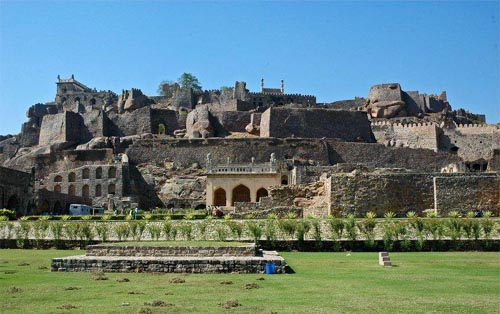Golkonda Fort

Information on Golkonda Fort (Hyderabad, Telangana) - History & Architecture
The Golkonda Fort is one of the popular ruined forts of Southern part of India largely visited by domestic and foreign tourists. During 1518 to 1687, Golkonda was the capital of medieval Golconda Sultanate. It is located just 11 km west of Hyderabad, in the state of Telungana, India. This particular region is worldwide popular for the mines that have largely produced the world's most coveted and famous gems such as the Darya-i-Noor, the Koh-i-Noor, the Nassak Diamond and the Hope Diamond.
Golkonda Fort Architecture
From architectural point of view, Golconda Fort has distinct architectural feature with 87 semi-circular bastions and has 10 kms outer wall and more of all beautifully architect royal apartments with mosques and temples inside. Apart from all these, there are many other important architectural buildings like Ambar Khana, Durbar Hall, Taramati Mosque, Mortuary bath, etc which enhance the beauty of the fort beyond imagination. The modern day technique and technology can hardly outfit the architectural splendor of Golconda Fort, which is worth to experience and relish.
The entire complex of the Golkonda Fort and its surrounding nearly spreads across more than 11 km of total area. The architectural beauty of this particular fort is revealed in many of the domes, entrances, gates and pavilions. In the olden days and present, the fort carried a large garden and green lawn. On the eastern side is located the main entrance to the fort knon as Bala Hissar Gate. In 1671, Toli Masjid was built by Mir Musa Khan Mahaldar ho as the royal architect of Abdullah Qutb Shah. It is situated about 2 km from the fort at Karwan. The major attraction of this fort are it's the famous "Rahban" cannon, water supply system, factories and palaces located within the premises. The "Kala Mandir" is also situated in the fort. An extension of Golkonda fort is the Naya Qila. Another attraction of this place is the Qutub Shahi Tombs.
Golkonda Fort History
The Golkonda fort was initially built by Kakatiyas as part and parcel of their defenses of western side of the kingdom. On the lines of the Kondapalli fort, it was in a successful manner built in 945 CE-970 CE. The well-planed fortress and city is surrounded by large crenellated ramparts and built on a granite hill that is 400 ft (120 meters) high. This particular Fort was strengthened and reworked by Pratapa Rudra who belonged to Kakatiya dynasty. Later on, this fort was further strengthened and reworked Musunuri Nayaks who perfectly overthrew the Tughlak army which was occupying Warangal.
In 1364 AD, Golkonda fort was successfully ceded by Kapaya Nayaka who was a Musunuri chief to the Bahmanis as part and parcel of the treaty. In the Sultanate, this fort region became the active capital of a major province and after its sudden collapse the significant capital of the Qutb Shahi kings. Finally, the fort fell into immediate ruins after a perfect siege and its great fall to Aurangazeb who was a Mughal emperor in 1687 AD. It is to be remembered that this particular fort and its market was the trading centre for world famous diamonds such as Darya-e Nur, Wittelsbach Diamond, Nur-Ul-Ain Diamond, The Regent Diamond, The Koh-i-noor, Princie Diamond and The Hope Diamond.
Golkonda Fort Tourism Importance
The Golkonda Fort is always thronged by domestic and foreign tourists throughout the year. It is just few kilometer away from Old city of Hyderabad. It is really easy to reach this fort. The visitors need to spend a day in order to explore the nook and corner of this fort in order to learn its magnificent structure and its architectural beauty.
- Andaman Nicobar Monuments
- Andhra Pradesh Monuments
- Assam Monuments
- Bihar Monuments
- Chhattisgarh Monuments
- New Delhi Monuments
- Goa Monuments
- Gujarat Monuments
- Haryana Monuments
- Himachal Pradesh Monuments
- Jammu and Kashmir Monuments
- Karnataka Monuments
- Kerala Monuments
- Madhya Pradesh Monuments
- Maharashtra Monuments
- Odisha Monuments
- Punjab Monuments
- Rajasthan Monuments
- Tamil Nadu Monuments
- Telangana Monuments
- Uttar Pradesh Monuments
- West Bengal Monuments